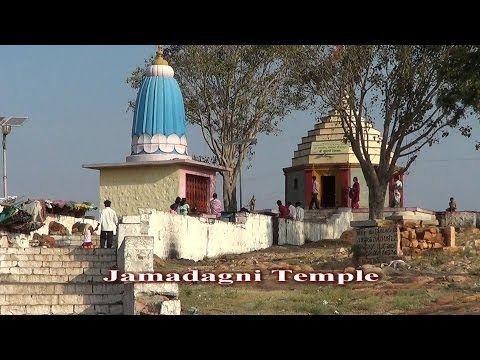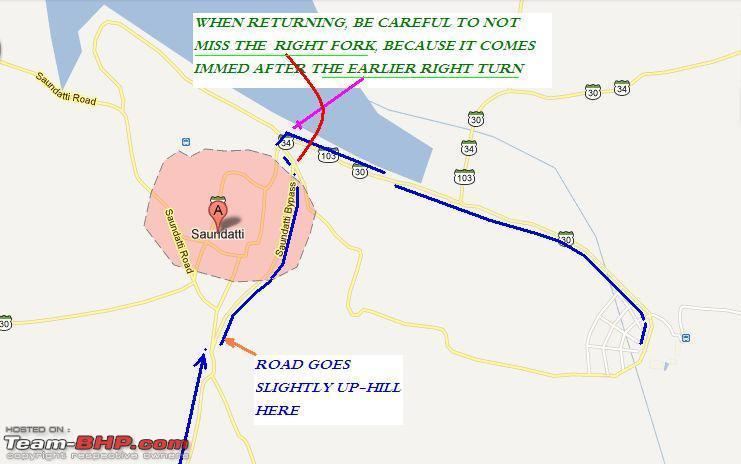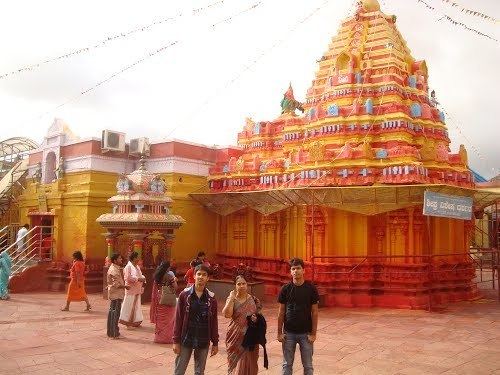Country Area 16 km2 District Belgaum district | Language spoken State | |
 | ||
Map of Saundatti
Saundatti also known as Sugandavarti and (Savadatti in Kannada) is one of the oldest towns in Belgaum district in the Indian state of Karnataka. It is a celebrated pilgrimage centre located 78 kilometres from Belgaum and 37 kilometres from Dharwad. Savadatti is also the name of the taluk (sub-district), which was previously named Parasgad. There are several ancient temples in Saudatti.
Contents
- Map of Saundatti
- Renuka yellamma temple savadatti saundatti
- Saundatti yellamma temple
- History
- The Rattas Rashtrakutas of Saundatti
- Inscriptions
- Jainism
- Savadatti fort
- Renuka Sagara
- Yallammagudda
- Navilatirtha
- Shirasangi Shri KalikaDevi Temple
- Savadatti Temples
- Puradeshwara temple
- Ankeshwara temple
- References

Renuka yellamma temple savadatti saundatti
Saundatti yellamma temple
History

The historical name of the Savadatti was Sugandavarti"Sougandipura". It was the capital of the Ratta dynasty (from 875-1230), until the capital shifted to Belgaum.
The Rattas (Rashtrakutas) of Saundatti
Inscriptions
Jainism
Savadatti fort
18th century Savadatti fort was built by the Sirasangi Desai with 8 bastions. Savadatti fort has a Kadasiddheshwara temple, surrounded by four bastions. Around the Kadasiddheshwara temple in the inner chajja of the prakara there is a row of beautiful carvings of geometrical patterns with over two hundred designs, some painted.
Renuka Sagara
Renuka sagara is a reservoir for the Malaprabha River adjacent to Saundatti, formed by the Navilatirtha Dam. The name Renuka sagar because of the famous Renuka (Yallamma) temple Yallammagudda Saundatti.
Yallammagudda
The temple of the goddess Yellamma or Sri Renukadevi, is a popular pilgrimage site for Shakti devotees. Every day, hundreds of pilgrims visit the temple with great devotion. The congregation is especially large, crossing the ten lakh mark on two auspicious days Banada Hunnime and Bharathi Hunnime. The century-old temple of Yellamma is situated atop Yellamagudda, amidst picturesque Ramalinga Hills about 5 km from Savadatti. Between Savadatti and the temple is the magnificent fort of Parashghad, dating back to the 10th century.
Navilatirtha
The Renukasagara, formed by the Navilatirtha Dam touches the low-lying areas of Saundatti. There is a spot called Jogulabhavi here, where there is a temple. Pilgrims take a holy dip here before visiting the Yellamma Hill. This Samādhi is in the area called Ramapur at Saundatti, which is humming with religious activities.
Shirasangi Shri KalikaDevi Temple
Shirasangi a small village located approximately 25 kilometers from Saundati is very famous for Shri Kalikadevi temple. The temple is known to be very ancient and is believed to be the place where Shringa maharishi worshiped Shri Kalikadevi. Shirasangi is also famous for Shri Tyagveera Lingaraja Desai. Shri Lingaraj was one of the main donors to give land to K.L.E Society.
Savadatti Temples
The town has temples dedicated to Ankeshwara, Puradeshwara, Nagarkere Mallikarjuna, Veerabhadra, Ulvi Basavaeshwara, Mouneshwara, Dyamavva and Venkateshwara, which is the largest.
Puradeshwara temple
The Puradeshwara temple in the later Chalukya style is a trikutachala with three ardhamantapas, a common navaranga and two mukhamantapas. Gurlhosur Chidambar temple is also an historical temple. All three garbhagrihas with pierced windows have shivalingas. The shikhara, now damaged, over the central garbhagriha is in Kadambanagara style and the navaranga pillars are lathe-turned. Inside the niches of the navaranga are images of Parvati and Veerabhadra. This temple has been renovated very crudely. On the day of Ugadi, the rising sun's rays fall directly on the main shivalinga. The outer walls have fine sculptures depicting Hindu mythology and there are inclined chajjas all round. The open mukhamantapa, a later addition, is also in the same style with massive pillars.
Ankeshwara temple
The Ankeshwara temple in Desaigalli, built by Rattas in 1048 is in the Western Chalukya style and is below the ground level. There are steps descending to the mukhamantapa. In front of the temple, there is an inscription carved into the wall by the builder, Ratta Chief Ankarasa.
